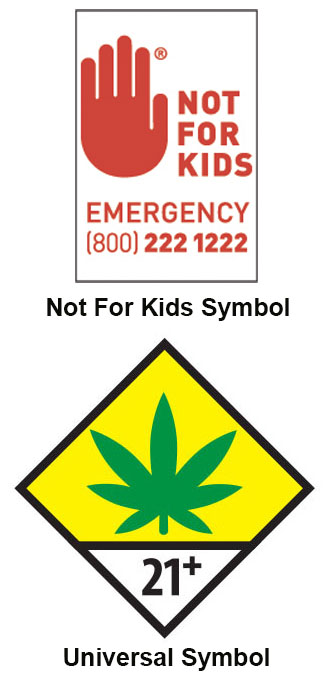Reading a Product Label
In addition to the business information for the cannabis producer or processor, labels on cannabis packaging must provide specific information to help you understand some aspects of the product you are buying.
The first step is knowing the terms on the label and why that information is important. Information in the Consumer Safety section on this website can help you to make informed decisions about what, how much, when, and where to consume cannabis.

Total THC and other cannabinoids
Different products have different amounts of cannabinoids. The amount of these compounds can determine how a product will affect you, especially the THC concentration.
- Edibles (like gummies, chocolates, and drinks) list the amount of THC per serving or unit and per package in milligrams (mg). These products may contain no more than 10 mg of THC per serving or unit, and 100 mg per package.
- Inhalable products, like pre-rolls, flower, and concentrates, list cannabinoid content as a percentage. Most cannabis flower products have between 12% and 25% THC. Concentrates generally fall between 60% and 90%, although some products can be lower or higher. Keep in mind that the presence of other cannabinoids, terpenes, and flavonoids may impact certain effects of THC. Pre-rolls may also have added a concentrate, increasing the percentage.
The primary display label on a package must clearly state the total amount of THC and CBD in the product.
Package means a container that has a single unit or group of units. Unit means an individual consumable item within a package of one or more consumable items in solid, liquid, gas, or any form intended for human consumption. |
Solvents
Some forms of cannabis extractions use solvents, such as ethanol and butane, to produce concentrates. If solvents are used, a statement that discloses the type of extraction method, including any solvents, gases, or other chemicals or compounds used to produce or added to the extract must be included on the label. This is important because residual solvents in the product can cause health issues.
Some labels may say “solvent-free” or “solvent-less.” This is an indication that the product avoids the potential health risks related to solvent residue.
See “Lab testing” below for more information.
Other content information
Depending on the type of product, a complete list of other chemicals, compounds, additives, thickening agents, terpenes, or other substances added must be provided. Edible products must include a list of ingredients and allergens.
Warnings
 Cannabis use is not without risks. Specific statements about health risks, a reminder that products are legal only for those 21 and older, and a caution to keep products out of the reach of children are required on cannabis product labels.
Cannabis use is not without risks. Specific statements about health risks, a reminder that products are legal only for those 21 and older, and a caution to keep products out of the reach of children are required on cannabis product labels.
Some warnings are required on all product labels, and some are for certain types of products:
- Warning – may be habit forming
- Unlawful outside Washington State
- It is illegal to operate a motor vehicle under the influence of cannabis
- Smoking is hazardous to your health (for inhaled products)
- “DO NOT EAT” in bold, capital letters (topicals)
- Caution: Intoxicating effects may be delayed by 2+ hours (for edibles)
The “Not For Kids” symbol is required on the label and contains the Poison Center number, (800) 222-1222. This is the number you can call if you or someone else is not feeling well after using the product or if the product is consumed by mistake by a child.
Universal Symbol
You will see this symbol on all legal (state regulated), adult-use cannabis products. This symbol allows you to quickly know if a product contains THC.
Note: Some illegal producers of cannabis have also placed this symbol on their packaging, making it appear that it comes from a state-licensed facility. To determine if the product was legally produced, consider other indicators, such as where it is sold, and whether the THC concentration in the product is within the state’s legal limits. (See section titled, “Is it legal? How to know.”
Optional information
“Best by” date, harvest date, and manufactured date are all optional for cannabis packaging and labeling.
Required accompanying information
The producer or processor must provide the following product-specific information, for as long as the product is for sale, through an internet link, web address, or QR code on the product label:
- A statement disclosing all pesticides applied to the plants during production of useable cannabis or on the cannabis used in the extraction process to create a concentrate or infused product.
- A list disclosing all chemicals, compounds, additives, thickening agents, terpenes, or other substances added to any cannabis concentrate during or after production.
Quality Assurance Information
Upon request – A consumer may request the name of the certified lab and quality assurance test results for any cannabis or cannabis product from a budtender. Some labels will provide the website or a QR code to access test results. The Certificate of Analysis (COA), shows the results of testing for harmful contaminants as well as specific cannabinoids present in a product.
Cannabis can change when exposed to air or other contaminants, so your COA will not be accurate forever.
See “Understanding test results” for information on how to read the COA.